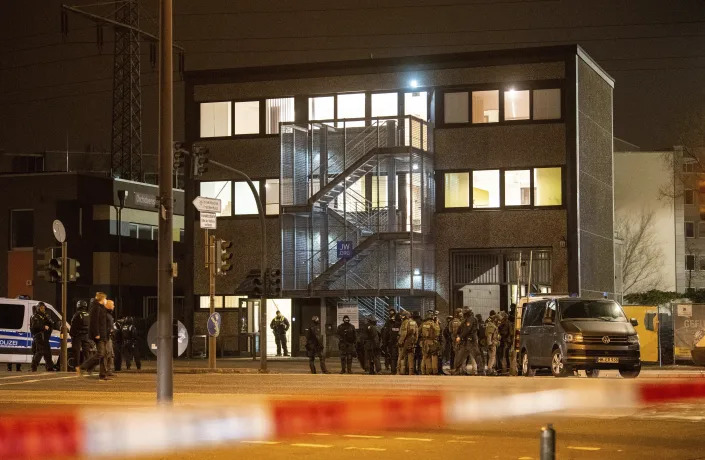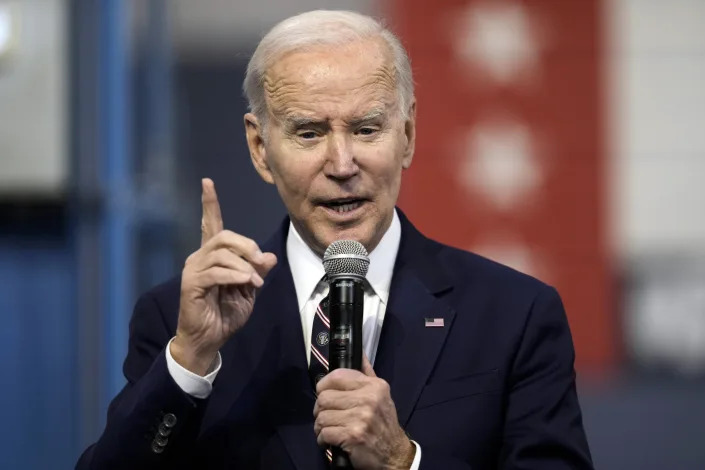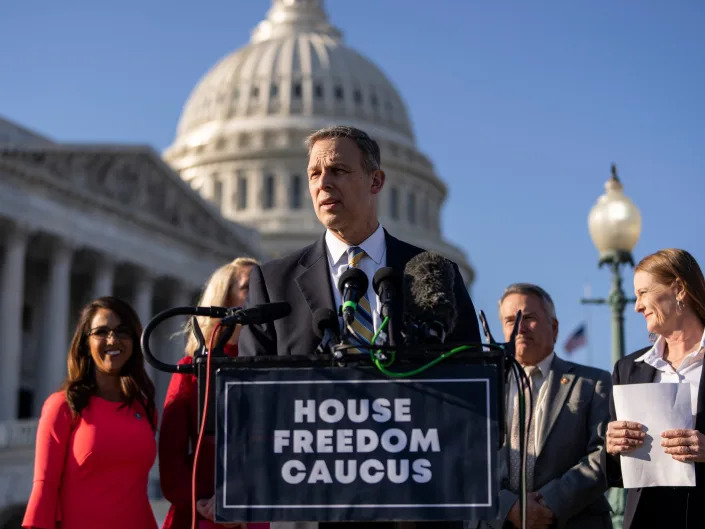Simon Usborne
Sat, March 11, 2023

Oksana Masters was born with severe disabilities, including missing shinbones and thumbs, which are thought to have been caused by her mother’s exposure to radiation after the Chernobyl disaster three years earlier, She went on to win 17 medals in the Paralympics, seven of them gold - Martin Schoeller
When Oksana Masters is having a bad day, her mother brings her sunflowers. Their petals contain layers of meaning for Masters, an athlete who was born in Ukraine; there, the flowers are a symbol of peace and pride. A vase of them overflows behind her as she speaks, via video call, from her home in Champaign, Illinois, a city south of Chicago.
‘It’s winter now so they’re really small but they make me so happy,’ says Masters, who wears a baggy Nike sweatshirt and fancy headphones. ‘In the middle of chaos, they still point to the sun, to the positive, to the light. And that’s what I need sometimes.’
Masters is 33. She was born in 1989 with severe disabilities, including missing shinbones and thumbs, which are thought to have been caused by her mother’s exposure to radiation after the Chernobyl disaster three years earlier. Her birth parents immediately handed her to the state, unwittingly dooming her to an early childhood of extreme cruelty and abuse.
At the last of three orphanages Masters was sent to, an upstairs room operated as a brothel for paedophiles. She was raped almost daily between the ages of five and seven. Beaten and cut for perceived transgressions, her medical needs were ignored and she became dangerously malnourished.
Gay Masters, an American academic, adopted her when she was seven. Oksana arrived in the United States so underweight that doctors diagnosed her with FTT – the medical term ‘failure to thrive’.
Twenty-six years later, after numerous operations, including the amputation of both legs, she has become one of the world’s most successful athletes.

This is the image of a young Oksana that inspired Gay Masters to adopt her - Oksana Masters
It’s a story she tells in her new memoir, The Hard Parts, an account of an improbable journey to the pinnacle of four Paralympic sports: rowing, cross-country skiing, cycling and biathlon. In a decade, she has won 17 medals for the USA, seven of them gold. The book is by turns difficult to read and to put down; ‘triumph over adversity’ barely covers it. It also comes out at a fraught time for the children of Chernobyl, thousands of whom are scattered across the world after being adopted.
The fallout from the nuclear disaster, on 26 April 1986, is still affecting people who were very young when a toxic cloud drifted over Ukraine, Belarus and Russia. And now, during its assault on Ukraine, Russia has repeatedly threatened the country’s working nuclear power plants, as well as the Chernobyl exclusion zone.
Early last year, tanks churned the contaminated soil as generals seized the site as a staging ground for an assault on Kyiv. The plant, which still requires careful management, has since returned to Ukrainian control, but the potential effects of further attacks or power outages remain a grave concern.
In the meantime, Vladimir Putin has raised the threat of nuclear war by vowing to use ‘all available means’ in his assault on Ukraine, reviving the existential angst that spread with that contamination more than 35 years ago.
The disaster at Chernobyl occurred when a botched safety test caused an explosive meltdown of the plant’s fourth reactor. It hastened the fall of the Soviet Union, fuelled Ukrainian nationalism and led to the creation of an exclusion zone with an almost-20-mile radius around the plant, from which more than 100,000 people were evacuated. This remains largely deserted.

The Chernobyl disaster occurred in April 1986 but its impact is still felt today - Igor Kostin/Laski Diffusion/Getty Images
Calculating the disaster’s direct – and lasting – human impact is notoriously difficult: a contested science that became political as part of a wider debate about the safety of nuclear energy. While the immediate death toll was – officially at least – 31, the United Nations estimated in 2005 that up to 4,000 people might eventually die as a result of radiation exposure. Other estimates of additional deaths associated with the accident range up to 200,000 between 1990 and 2004, according to a Greenpeace report.
Meanwhile, research has linked more than 6,000 cases of thyroid cancer to radiation exposure in people who were children in the area in the late 1980s.
The war and nuclear threat from Russia also comes at a time when members of the Chernobyl generation are in their 30s and have had, or are considering having, families of their own. For those with traumatic upbringings, this can be an emotional challenge. Fear also lingers about the potential for gene mutations to be passed on, though a study of more than 200 Chernobyl survivors and their children by the National Research Centre for Radiation Medicine in Kyiv, published in 2021, found no evidence of such a transgenerational effect.
Raisa Carolan has watched events unfold with dread. She is 30 now, and was raised in orphanages in Belarus, where she was born, before being adopted by an Irish family at the age of 10. She too had suffered from neglect and cruelty, and would later require more than 30 operations, including the amputation of one leg.

Raisa Carolan as a child in 1997
‘For the first couple of weeks after the invasion I was very emotional because I felt a lot of hurt for them,’ Carolan says. ‘When Chernobyl happened, they had to leave their homes and now there’s this.’
Carolan was born seven years after the disaster and has long grappled with its effects. ‘It’s scary and fascinating to think that one nuclear disaster pretty much defines you,’ she says. ‘But I try not to get too much into the “What if?” of it all. I can either let it define me in a negative way or I can toss it around and think, look, it is what it is.’
Janina Scarlet was almost three when the reactor blew up not far from her hometown in Ukraine. Her father, a machinist, and her mother, a nursery teacher, later told her what happened next: that people in her town understood there had been an explosion but were told by the authorities there was nothing to worry about. ‘So for days people continued going outside, breathing the air and drinking water and eating raw fruit, not knowing that it was poisoned,’ says Scarlet, who is now 39.
Scarlet spent much of her childhood in hospitals with immune problems and crippling migraines. But her earliest memories are of a deep anxiety, and thinking that everyone was going to die. When people did die, it added to the sense of an invisible threat hanging in the air. ‘I just remember a lot of funerals,’ she adds.

Young Janina in the summer of 1986
Another threat was antisemitism. Attacks on members of Scarlet’s family prompted them to flee to New York when she was 12. Her grandparents had endured Nazi occupation during the Second World War. ‘Going through war again now, and having Holocaust memorials destroyed, it’s just devastating,’ she says of the recent Russian assault.
When Putin launched his full-scale invasion in February last year, Oksana Masters was preparing to fly to Beijing to compete in the 2022 Paralympic Winter Games. She still feels a kinship with the people of Ukraine. ‘I called my mom when the sirens started going off on the news with the first bombs,’ she recalls. ‘We were just crying on the phone.’
Her memories of Ukraine are mostly bad; but she has a visceral recollection of the moment, in the middle of the night, that she first peered up at Gay from her bed. Her mother had long dreamed of having a child. ‘She knelt down and just touched the bed so gently, and was such a calming presence,’ Masters recalls. ‘When I looked at her I already felt like I was home… that’s where I started living, in a way that’s when I was born.’
In America, surgeons were amazed that she had managed to fashion a walking style with 12 toes, no functional shins and a six-inch discrepancy in leg length. The first above-knee amputation came when she was nine, the second at 14. Masters had a love-hate relationship with her prosthetic legs, and tried desperately to fit in at school.

Oksana, 14, after the amputation of her second leg - Oksana Masters
Her hands, meanwhile, bore the scars of multiple operations to remove webbing and create opposable thumbs from two of her 10 fingers. ‘People are constantly staring at them,’ Masters writes in her memoir before detailing a failed attempt, in her teens, to cut off her fingers with kitchen scissors. She remembers feeling no pain.
At 13, Masters tried out rowing; one of her teachers ran a programme for disabled people. She still remembers the hypnotic feeling of floating and the water pushing against her oars. Soon, she threw herself into training, taking advantage of her ability to shut out physical pain. After 10 years, she paired up with an army veteran who had lost his legs in Afghanistan and made it to London 2012. In the ‘trunk and arms’ mixed double sculls, they won bronze.
It would take a new sport and six more years for Masters to reach the top of the Paralympic podium, after a chance meeting with a cross-country skiing coach. Paralympic cross-country skiers without legs sit on a kind of sled, propelling themselves with strong arms and poles. In the biathlon, they also hurl themselves and their sleds to the ground to shoot at targets.
Her sporting career, together with her mother’s love, offered Masters, she says, an outlet for the anger that had long boiled inside her. ‘It was the combination of that nurture and affection and feeling safe, with a place where I could just physically release everything.’

Oksana showing off one of her medals with her mother - Oksana Masters
For years, Masters knew little of her birth parents. But in 2015 she received a Facebook message from her biological brother in western Ukraine. He had seen a news report about her Paralympic success, and told her that their biological parents were anxious to meet her; their mother had been very poor, he said, and had given her up reluctantly on the recommendation of doctors.
It fuelled a longing for a face-to-face meeting with them, though this hadn’t taken place by the time Putin launched his recent attack. She understands that they have so far stayed safe during the invasion.
‘Now my fear is that I’ll never be able to go back,’ she admits. ‘Because there’ll be no country to go back to.’
Janina Scarlet has no obvious physical challenges as a result of growing up in Chernobyl, although migraines still dog her; but the anxiety that took root during her childhood in Ukraine followed her to America, where she still lives. She was bullied at school and became suicidal in her early teens. ‘Kids would ask me if I was radioactive and if I glowed in the dark,’ she recalls.
The disaster was too much to contemplate. ‘Until my early 30s, I couldn’t even say the word “Chernobyl”. My body would almost shut down.’
A trip to the cinema when she was 16 changed Scarlet’s life. Watching X-Men, a story about ‘mutants’ with superpowers, she began to see herself as a survivor rather than a victim.
The film inspired Scarlet to take a psychology class. Decades on, she’s an award-winning clinical psychologist and author who specialises in treating trauma; in the past year, she has also supported psychologists in Ukraine with remote courses.

Janina Scarlet - Janina Scarlet
Raisa Carolan, meanwhile, is still coming to terms with everything she has been through. Adopted by her Irish family thanks to the charity Chernobyl Children International (CCI), she doted on her mother, Ann. But when she was 16, Ann had a stroke and died. The loss was devastating. ‘It was like being abandoned all over again,’ Carolan says. ‘I was afraid everybody was going to leave me, so I couldn’t get close to them.’
Today she works as an online safety specialist for Google in Dublin, and has developed a growing curiosity about her past. In 2021, she found her biological brother online. They have exchanged messages and Carolan has learned about how difficult life has become in Belarus as a result of sanctions imposed over the country’s support of Russia.
She fears that her brother may be conscripted, and that the reunion she wants may now be out of reach. ‘Until I find out everything about my past,’ she tells me, ‘I’m always going to feel like there’s something missing.’
For Oksana Masters, writing her memoir was part of her own search for missing things. Her mother Gay had not been aware of some of the abuse her daughter had faced until she read early drafts. ‘She just cried because she felt like she had failed because I’d been too afraid to go to her,’ Masters says. ‘But she also understood that I had no idea what to say.’
One of the memories most difficult to put to paper was that of Laney, her best friend in the orphanage and – until Gay came along – the only person who used to hug her or hold her hand. Masters’ love of sunflowers started with Laney too; the girls dreamed of walking through them together. One night in the orphanage, Masters encouraged Laney to join her in a search for bread. She remembers slipping, attracting the attention of staff. Laney pushed her out of harm’s way under a table, only to be caught and beaten so badly that she died.
Masters has only recently felt able to express the grief and guilt she has carried for decades. ‘My mom knows that sunflowers to me aren’t just flowers,’ she says, her voice cracking. ‘They’re how I see Laney and all the good things she meant, which almost makes me forget that anything bad happened.’
Little is known about what became of many of the children born in the aftermath of Chernobyl. A number estimated to be in the ‘low thousands’ were adopted by families all around the world, according to CCI.
\
Given all that they have been through, perhaps the most remarkable thing about Oksana Masters, Raisa Carolan and Janina Scarlet is the extent to which they are high-achieving, well-rounded adults. They may have benefitted from what psychologists call ‘post-traumatic growth’ – or the ability to use trauma as a catalyst.
This was certainly true of Masters. After winning a silver medal in a cross-country skiing event at the Sochi Paralympic Winter Games in 2014, she went on to compete again in 2018, in Pyeongchang, South Korea. Major brands, including Nike and Visa, were competing to sponsor her. She has also found the love of her life in Aaron Pike, a dashing champion wheelchair racer and cross-country skier. The couple live together in Champaign and have talked about adopting a child of their own.
But life has not been without further challenges: three weeks before the Games in Pyeongchang, Masters broke her elbow after falling on a patch of ice. Competing risked permanent damage, but with major strapping, she made the starting line.
When the pain became almost too much to bear in the closing stages of the dramatic 1.1km cross-country sprint event, Masters remembers feeling a nudge from behind, yet turning around to find nobody there.
Slumping to the ground after winning her first Paralympic gold medal, the pain gave way to a crazed reel of images, mainly featuring the two most important people in her early life. ‘It started with my memories of Ukraine, and meeting Mom,’ she says, her voice cracking before she glances at the sunflowers.
‘And there was Laney, who I know was the one pushing me to the finish line.’
The Hard Parts, by Oksana Masters, is out now (Simon & Schuster)















